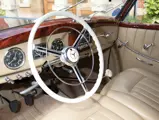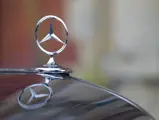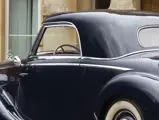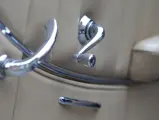London 2013
1951 Mercedes-Benz 170 S Coupé
Mercedes Collection
{{lr.item.text}}
£250,000 - £300,000 GBP | Not Sold
 | London, United Kingdom
| London, United Kingdom
{{internetCurrentBid}}
{{internetTimeLeft}}

52 bhp, 1,767 cc L-head inline four-cylinder engine, four-speed manual transmission, transverse leaf-spring front suspension, swing axle rear suspension with coil springs, and four-wheel hydraulic drum brakes. Wheelbase: 2,845 mm
Following a tradition which had been established before World War II, Mercedes’ post-war, entry-level models offered a level of sophistication in engineering nearly equal to that of the largest cars. The basic design of the 170 model dated back to 1931, and it was still suitable some 20 years later. Indeed, the 170 would remain in production, in all of its variations, until 1955.
Offered here is an extraordinary, special example, a one-off coupé ordered new by Dr Wilhelm Manchot, a German chemist working for Henkel & Cie GmbH, an industrial firm based in Düsseldorf. Dr Manchot became a general manager of the firm in 1939, and he was also on the board of directors of Henkel & Cie AG. This Mercedes is believed to be a company car, as delivery was made to Henkel & Cie.
This car was built as a cabriolet on 30 April 1951, and it was immediately taken to coachbuilder Hebmüller to be converted into a coupé with a sunroof, because Dr Manchot preferred a closed car to protect him from the wind. Interestingly, it is known that this same sort of conversion was done by Hebmüller for the Henkel family on an earlier 540 K. It has been surmised that, in this case, the top was likely provided by Mercedes-Benz. It would have been a piece similar to that used on other one-offs built for Mercedes-Benz executives at the time, and it was similar to those that would ultimately be used on the production 220 coupés from 1954–1955.
This outstanding car was originally finished in dark blue with grey leather upholstery and rosewood trim. The build sheet also has a number of notations that indicate that it was an extremely specialised delivery. The coupé was first registered for the road in 1951, and it stayed with Dr Manchot until it was passed to Dr Eric Maret, of Hamburg, in 1955; the car would be with several more owners, all in Hamburg, through 1970.
For an early post-war vehicle, Dr Manchot’s Mercedes was recognised as a collectible relatively early on in its life. It received a body-off restoration between the years of 1986 and 1998. A massive file contains several photographs of the restoration and correspondence pertaining to the project. In addition is a FIVA Identity Card, an owner’s manual, a repair manual, a copy of the original delivery documentation, and various invoices and correspondence pertaining to the history of the car. RM strongly encourages any prospective bidders to request to review this wonderful trove of documentation prior to the auction.
The car was beautifully restored and is filled with numerous interesting features, such as a sliding sunroof, a Siemens radio with a special exterior antenna, built-in trafficators to the rear of both doors, smoked-grey glass sun visors, and beautifully detailed courtesy lights over both doors. Opening the boot reveals an original, unrestored three-piece set of exquisitely tailored luggage by Karl Baisch, of Stuttgart, with a spare and tyre change kit beneath. The rear seat, ideal for two children, can be folded down to form a useful shelf for parcels or additional touring luggage. Even the exhaust on this car is a work of art: a flared fishtail outlet that emerges from under the rear bumper.
Whilst the car appears to have been driven some 6,700 kilometres since restoration, it shows only light wear throughout, which would be easily taken care of with a thorough detailing. Afterwards, it would continue to be an interesting and beautiful addition to any collection of coachbuilt German automobiles. Everywhere one looks, there are fascinating and intricate details to admire.






























